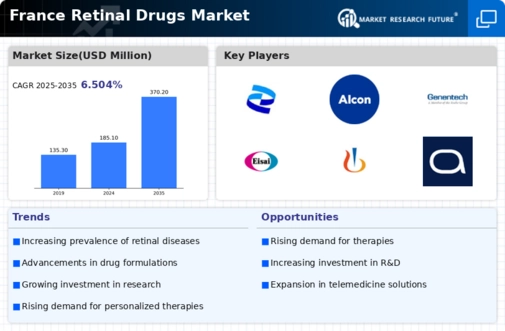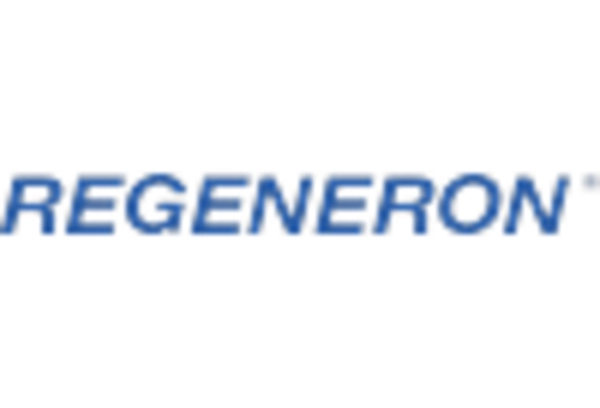Rising Awareness and Screening Programs
Increasing awareness about eye health and the importance of early detection of retinal diseases is driving the retinal drugs market in France. Public health campaigns and screening programs have been implemented to educate the population about conditions such as diabetic retinopathy and AMD. These initiatives have led to a rise in the number of individuals seeking regular eye examinations, which in turn facilitates early diagnosis and treatment. According to recent statistics, screening programs have resulted in a 30% increase in early-stage diagnoses of retinal diseases in the past two years. This heightened awareness not only promotes timely intervention but also boosts the demand for effective retinal drugs. As more patients are diagnosed and treated, the market is likely to experience sustained growth, reflecting the positive impact of these awareness initiatives.
Government Initiatives and Funding for Eye Health
Government initiatives in France aimed at improving eye health are significantly influencing the retinal drugs market. The French government has allocated substantial funding for research and development in ophthalmology, with an emphasis on innovative treatments for retinal diseases. In 2025, the government announced a €50 million investment to support clinical trials and the development of new retinal therapies. Such initiatives not only enhance the research landscape but also encourage collaboration between public institutions and private companies. This funding is likely to accelerate the introduction of novel drugs into the market, thereby addressing the unmet needs of patients suffering from retinal disorders. The proactive stance of the government in promoting eye health is expected to create a favorable environment for the growth of the retinal drugs market.
Technological Advancements in Drug Delivery Systems
Technological innovations in drug delivery systems are transforming the retinal drugs market in France. The development of sustained-release formulations and targeted delivery mechanisms enhances the efficacy of retinal therapies. For instance, intravitreal injections have become a standard method for administering drugs directly to the retina, improving bioavailability and reducing systemic side effects. The market for these advanced delivery systems is projected to grow at a CAGR of 8% from 2025 to 2030. Additionally, the integration of nanotechnology in drug formulation is likely to enhance the precision of treatments, making them more effective for patients. As these technologies continue to evolve, they are expected to play a pivotal role in shaping the future of the retinal drugs market, offering new avenues for treatment and improving patient outcomes.
Aging Population and Rising Incidence of Eye Diseases
The aging population in France critically drives the retinal drugs market. As individuals age, the prevalence of age-related eye diseases, such as age-related macular degeneration (AMD) and diabetic retinopathy, is significantly increasing. Reports indicate that by 2030, approximately 25% of the French population will be over 65 years old, leading to a higher demand for effective retinal therapies. This demographic shift necessitates advancements in treatment options, thereby propelling growth in the retinal drugs market. Furthermore, the French healthcare system is increasingly focusing on providing innovative solutions to manage these conditions, which may further stimulate market expansion. The combination of an aging population and the rising incidence of eye diseases creates a substantial opportunity for pharmaceutical companies to develop and market new retinal drugs.
Collaboration Between Pharmaceutical Companies and Research Institutions
Collaboration between pharmaceutical companies and research institutions is emerging as a vital driver for the retinal drugs market. Such partnerships facilitate the sharing of knowledge, resources, and expertise, leading to accelerated drug development processes. In France, several notable collaborations have been established, focusing on innovative therapies for retinal diseases. These alliances often result in the pooling of funding and talent, which can significantly reduce the time required to bring new treatments to market. For instance, a recent partnership between a leading pharmaceutical firm and a prominent research university aims to develop gene therapies for inherited retinal disorders. This collaborative approach not only enhances the research capabilities but also fosters innovation within the retinal drugs market, potentially leading to groundbreaking therapies that address critical patient needs.

















Leave a Comment